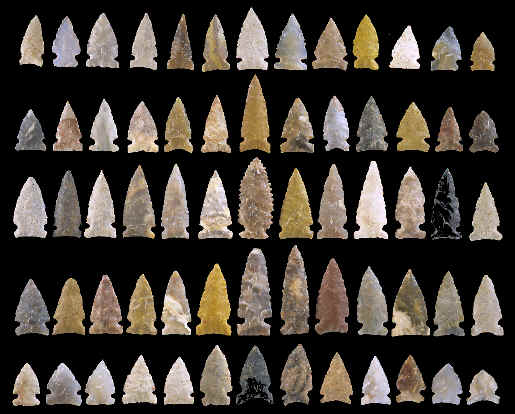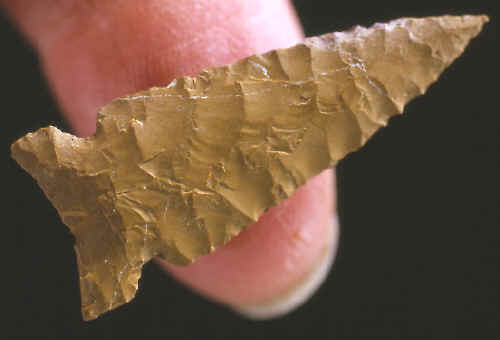|
||
|
||
|
"There is a narrow, steep sided and dead-end ravine near Conrad into which small game was driven and killed by the Indians in ancient times using bow and arrows."---From an old tag on the back of this frame of Avonlea points that were excavated by H.P. Lewis sometime before 1941.
AVONLEA ARROWHEADS The Avonlea type site is located in Saskatchewan, Canada 75 miles north of Montana and 3 miles east of the town of Avonlea. Avonlea arrow points have also been found on sites in the northwestern Plains of Montana, the Dakotas, Wyoming and in the provinces of Ontario and Manitoba. The Avonlea type site was originally brought to the attention of archaeologists in 1956 by Alan J. Hudson. Mr. Hudson, who is described as a "keen amateur archaeologist," was the first person to excavate there. In September, 1956 his 4x5 foot square test excavation produced flakes, bones and arrow points. In October of the same year McCorquodale and A. Swanston excavated a 5x5 foot square next to Hudson's. That excavation produced various stone artifacts and bones plus a radiocarbon sample that produced a date of A.D. 450. The site was again tested in 1984 by McCorquodale, Swanston and Hudson. They opened seven one meter squares to a depth of 13 3/4 inches (35cm.) and found 23 Avonlea points, a stone knife, cores and flakes, a hammerstone, bone tools and one potshard. |
||
|
The Avonlea site is thought to be a bison kill site where animals were either driven over a sharp declivity (hill) or along a flat area below into a "notch". The site is located in the Avonlea Creek valley on a lower slope of the west wall approximately 100 feet from a dry meandering wash that had cut into the wall. Cultivation of the land above and below the valley wall has erased any evidence of the drive lines (directions where the animals were herded into the trap). |
||
|
Avonlea arrow points are recognized as useful markers for early Late Prehistoric period sites in the Northwestern Plains. Investigation of these sites began as early as 1941 with H.P. Lewis. He was a professor and Superintendent of Schools in Conrad, Montana. All the Avonlea points pictured in this article were excavated by him from a bison kill site located in a narrow, steep sided and dead-end ravine near Conrad. |
||
| CONTINUE ON TO PAGE TWO | ||
|
"REFERENCES"
1985,
"Selected Preforms, Points and Knives of the North American
Indians," Vol. I, by Gregory Perino, p.23. |
||




